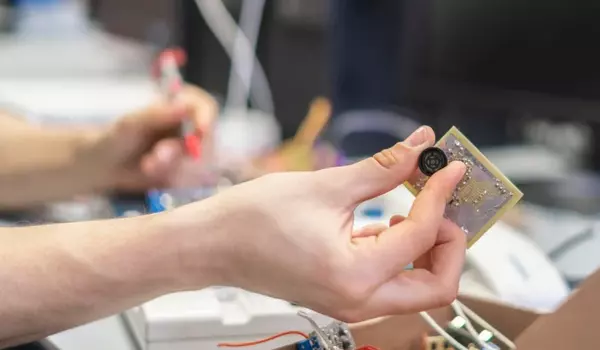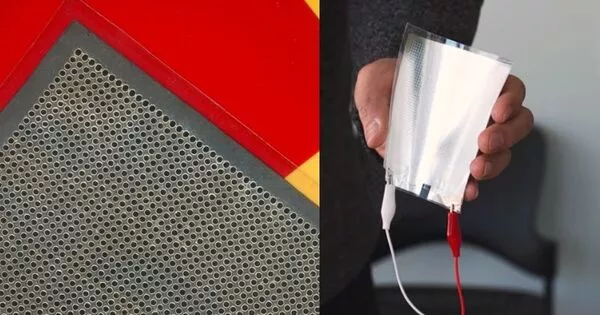Researchers developed an ultrathin loudspeaker capable of transforming any rigid surface into a high-quality, active audio source. Thin-film devices can be produced at scale thanks to the fabrication process.
Engineers at MIT have created a paper-thin loudspeaker that can convert any surface into an active audio source. This thin-film loudspeaker produces minimal distortion while consuming a fraction of the energy required by a traditional loudspeaker. The team demonstrated a hand-sized loudspeaker that weighs about the same as a dime and can produce high-quality sound regardless of the surface to which the film is bonded.
The researchers pioneered a deceptively simple fabrication technique that requires only three basic steps and can be scaled up to produce ultrathin loudspeakers large enough to cover the inside of an automobile or wallpaper a room.
When used in this manner, the thin-film loudspeaker could provide active noise cancellation in noisy environments such as an airplane cockpit by producing sound with the same amplitude but opposite phase; the two sounds cancel each other out. The adaptable device could also be used to provide immersive entertainment, such as three-dimensional audio in a theater or theme park ride. Because it is lightweight and requires so little power to operate, the device is well-suited for applications on smart devices with limited battery life.
It feels remarkable to take what looks like a slender sheet of paper, attach two clips to it, plug it into the headphone port of your computer, and start hearing sounds emanating from it. It can be used anywhere. One just needs a smidgeon of electrical power to run it.
Vladimir Bulović
“It feels remarkable to take what looks like a slender sheet of paper, attach two clips to it, plug it into the headphone port of your computer, and start hearing sounds emanating from it. It can be used anywhere. One just needs a smidgeon of electrical power to run it,” says Vladimir Bulović, the Fariborz Maseeh Chair in Emerging Technology, leader of the Organic and Nanostructured Electronics Laboratory (ONE Lab), director of MIT.nano, and senior author of the paper.
A new approach
A typical loudspeaker found in headphones or an audio system uses electric current inputs that pass through a wire coil that generates a magnetic field, which moves a speaker membrane, which moves the air above it, and thus produces the sound we hear. The new loudspeaker, on the other hand, simplifies speaker design by employing a thin film of a shaped piezoelectric material that moves when a voltage is applied to it, which moves the air above it and generates sound.
Because the film must bend freely to produce sound, most thin-film loudspeakers are designed to stand alone. Mounting these loudspeakers on a surface would impede vibration and reduce their ability to generate sound.
To overcome this problem, the MIT team rethought the design of a thin-film loudspeaker. Rather than having the entire material vibrate, their design relies on tiny domes on a thin layer of piezoelectric material which each vibrate individually. These domes, each only a few hair-widths across, are surrounded by spacer layers on the top and bottom of the film that protect them from the mounting surface while still enabling them to vibrate freely. The same spacer layers protect the domes from abrasion and impact during day-to-day handling, enhancing the loudspeaker’s durability.

The researchers used a laser to cut tiny holes in a thin sheet of PET, a lightweight plastic, to create the loudspeaker. They laminated the underside of that perforated PET layer with a very thin film of piezoelectric material called PVDF (as thin as 8 microns). They then used a vacuum to lift the bonded sheets and a heat source set to 80 degrees Celsius to place beneath them.
The PVDF layer bulged because of the pressure difference created by the vacuum and heat source. Because the PVDF cannot force its way through the PET layer, tiny domes protrude in areas where the PET layer is not present. These protrusions align themselves with the holes in the PET layer. The researchers then laminate the other side of the PVDF with another PET layer to act as a spacer between the domes and the bonding surface.
“This is a very simple, straightforward process. It would allow us to produce these loudspeakers in a high-throughput fashion if we integrate it with a roll-to-roll process in the future. That means it could be fabricated in large amounts, like wallpaper to cover walls, cars, or aircraft interiors,” Han says.
High-quality, low power
The domes are 15 microns tall, about one-sixth the thickness of a human hair, and when they vibrate, they only move up and down about half a micron. Because each dome is a single sound-generation unit, producing audible sound requires thousands of these tiny domes vibrating together.
The researchers can control the size of the domes by changing the size of the holes in the PET, which is an added benefit of the team’s simple fabrication process. Larger domes displace more air and produce more sound, but they also have a lower resonance frequency. Lower resonance frequency causes audio distortion. The resonance frequency is the frequency at which the device operates most efficiently.
Once the researchers perfected the fabrication technique, they tested several different dome sizes and piezoelectric layer thicknesses to arrive at an optimal combination. They tested their thin-film loudspeaker by mounting it to a wall 30 centimeters from a microphone to measure the sound pressure level, recorded in decibels. When 25 volts of electricity were passed through the device at 1 kilohertz (a rate of 1,000 cycles per second), the speaker produced high-quality sound at conversational levels of 66 decibels. At 10 kilohertz, the sound pressure level increased to 86 decibels, about the same volume level as city traffic.
The device requires only about 100 milliwatts of power per square meter of speaker area. In comparison, an average home speaker may require more than one watt of power to produce comparable sound pressure at a comparable distance.
Because the tiny domes are vibrating rather than the entire film, the loudspeaker has a high enough resonance frequency to be useful for ultrasound applications such as imaging, according to Han. Ultrasound imaging creates images by using very high-frequency sound waves, and higher frequencies produce better image resolution.
















